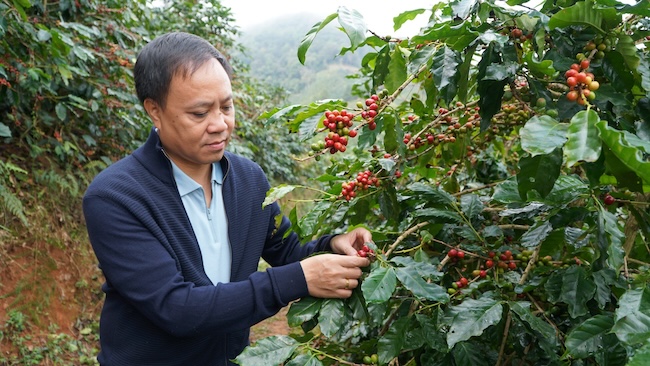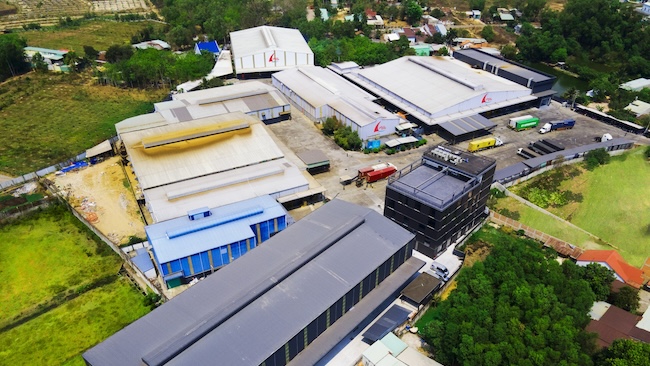Vietnam turns semiconductor vision into action
The global semiconductor industry is being reshaped by geopolitical tensions, shifting supply chains, and the surge of digital technologies.




Coffee prices have been steadily increasing over the past few months, leading export businesses to incur significant losses in order to fulfill orders.
The fluctuation in coffee prices in recent months has notably impacted businesses operating within the industry, particularly export-oriented enterprises whose contracts are typically signed in advance.
Addressing this issue, TheLEADER engaged in a brief exchange with Phan Minh Thong, Chairman of Phuc Sinh Group, one of the leading coffee export companies.
Could you inform us of the current spot price for coffee? How does this price compare to the same period last year and to the end of 2023?
Phan Minh Thong: Recently, the domestic market has witnessed numerous instances of high prices, with transactions reaching between VND94,300 and VND94,800 VND per kilogramme.
I recall that in November last year, prices fluctuated around VND59,000 to VND60,000, but within a month, they rose to VND62,000 to VND69,000 per kilogramme.
However, this upward trend has not ceased. At the beginning of 2024, prices were recorded at around VND70,000 - 82,000 and they continue to skyrocket to VND86,000 - 94,500 per kilogramme.
As we can see, in just a few months, coffee prices have nearly doubled, leaving businesses struggling to keep up.
What factors have caused such significant fluctuations in coffee prices?
Phan Minh Thong: The primary reason stems from the disruption of the global supply chain that has yet to fully recover after Covid-19.
Meanwhile, prolonged tensions between Russia and Ukraine have exacerbated difficulties for the coffee industry as fertilizer supply becomes scarce, energy prices skyrocket, and production costs surge.
Moreover, inflation has also driven up production costs while the global coffee supply is facing numerous challenges.

How have the significant fluctuations in coffee prices affected stakeholders in this market, including export businesses like Phuc Sinh, purchasing agents, and growers?
Phan Minh Thong: First, we need to understand the relationships in the coffee market to grasp the impacts of price issues better.
Typically, the coffee market follows an eternal rule, that means in the first three months of the crop season, export companies like Phuc Sinh and traders will plans to sell about half of the output through contracts and process established at that time.
However, when it comes to the harvest season, companies are faced with excessively high prices compared to their estimates and sometimes, there is no stock available for delivery, making it impossible to adapt quickly.
The reason is that when prices rise, farmers want to hoard their produce, reluctant to sell to traders or export companies or even renege on deals signed to renegotiate at higher prices.
This shows that even Vietnamese export companies, including Phuc Sinh, find it difficult to manage when prices fluctuate so wildly. Within a single harvest, prices double, while farmers breach contracts, breaking established relationships that have existed for many years.
As one of the leading coffee export businesses, how has Phuc Sinh specifically encountered difficulties when the market is so volatile?
Phan Minh Thong: One of the first issues is high demand but minimal sales volume. There have been times when we had to demand thousands of tons because we received deposits but couldn't deliver to buyers.
Then, with signed contracts, we were forced to buy at high prices to fulfill orders, leading to losses and difficulties, especially in revolving capital. Each ton incurred losses of tens of millions dong, and with contracts reaching hundreds or thousands of tons, the losses were substantial.
Thus, even though there is higher price during the season, export companies or foreign companies end up paying a considerable cost or even loss.

In the past, has Phuc Sinh encountered similar situations? What are the experiences in dealing with such significant market fluctuations?
Phan Minh Thong: I remember about ten years ago, Vietnamese black pepper was highly priced, around $6,000 - $7,000 or even up to $11,000 per ton. Everyone was enthusiastic about growing pepper.
However, just two years later, in 2017, prices plummeted to less than a quarter, around $2,500 per ton. The consequence was shattered business plans and many other tragic stories.
I also remember when I visited some farms, many farmers stored their produce to wait for prices to rise, but the result was a plunge from VND220,000/kg (about $8.8) to less than VND40,000/kg (about $1.6).
That shock led to a wave of farmers abandoning their farms or switching to other crops, resulting in a significant decrease in Vietnam's black paper output over the past decade.
With such market fluctuations, what solutions has Phuc Sinh implemented?
Phan Minh Thong: With high price as now, one solution Phuc Sinh is implementing is shifting to purchasing coffee from Brazil.
Although most buyers prefer Vietnamese robusta over Brazilian products, due to the excessively high and difficult-to-obtain prices, we are forced to switch some purchases to Brazil.
Additionally, we are adjusting the ratio, increasing the proportion of arabica to compensate for demand.
How do you evaluate the role of risk assessment for businesses, especially given the current context of various potential risks such as inflation and geopolitical risks?
Phan Minh Thong: I believe risk assessment is becoming increasingly important as the world is constantly changing and some events are unpredictable for businesses.
Previously, risk could only be planned for in the short term, but now, businesses need to have a longer-term outlook and more contingency plans to avoid being passive when issues arise.
In practice, all predictions are probabilities, so coffee export businesses and purchasing agents should monitor coffee prices daily, understand why prices are rising sharply, and develop appropriate contingency plans.
I also believe that risk assessment needs to be taken seriously and worthy investments made, based on specific data rather than intuition. It's better to incur a little extra cost for risk management than to lose millions of dollars along with customers.
The global semiconductor industry is being reshaped by geopolitical tensions, shifting supply chains, and the surge of digital technologies.
The change in APA approval authority is expected to shorten processing time and enhance business proactiveness in international tax negotiations.
As hybrid cloud systems grow more complex, Vietnamese enterprises are struggling to detect cybersecurity threats moving laterally within their own networks.
The submission of the draft resolution on Vietnam’s international financial center to the National Assembly heralds a new developmental era for the country.
More than just running a 5-star resort, Kristian Petersen is redefining the art of hospitality with a humane and sustainable leadership philosophy.
For Tyna Huynh, co-founder of Drinkizz, organic is not just a food choice but a way of life that fosters a deep connection between people, nature and community.